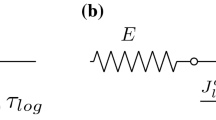Summary
The modulus of torsion and the mechanical damping has been investigated on test pieces of beech wood (Fagus sylvatica L.) with transverse fibre direction by means of a torsional pendulum. Both characteristics have been determined as a function of temperature (from 20 ... 100°C) and moisture content (from 5 percent to fibre saturation). At a frequency of about 1 cycle per second a transition region has been found characterized by a large decrease of the modulus of torsion and a distinct maximum of damping.
The temperature-dependent processes of relaxation with well-defined activation energy lie at moisture contents of more than 12 percent. They have been interpreted by molecular motions which take place between the secondary valencies of the hydroxyl groups in the amorphous areas of the partial crystalline substance of the cell wall and which are favoured by the incorporation of water. The transition region is displaced to lower temperatures with increasing moisture content. In this respect the moisture content acts analogically to synthetic polymers as a plasticizer. The “efficiency” of plasticizers, which is the correlation between the concentration of the plasticizer and the temperature displacement of the maximum of damping respectively of the decrease of the modulus of torsion, is also used for a characterization of the influence of moisture content on the viscoelastic behaviour of the native high polymer wood.
Zusammenfassung
An quer zur Faser orientierten Proben aus Buchenholz (Fagus sylvatica L.) wurden der Drillungsmodul und der mechanische Verlustfaktor mit einem Torsionspendel gemessen. In Abhängigkeit von der Temperatur (von 20 ... 100°C) und der Holzfeuchtigkeit (von 5% bis Fasersättigung) wurde bei Frequenzen im Bereich von 1 Hz ein Dispersionsgebiet mit starkem Modulabfall und ausgeprägtem Dämpfungsmaximum gefunden.
Die temperaturabhängigen Relaxationsprozesse mit eindeutiger Aktivierungsenergie liegen bei Holzfeuchtigkeiten oberhalb 12%. Sie werden in der Weise gedeutet, daß in den amorphen Bereichen der partiell kristallinen Zellwandsubstanz Molekülbewegungen zwischen den Nebenvalenzen der Hydroxylgruppen entstehen, die durch die Einlagerung des Wassers begünstigt werden. Mit zunehmendem Holzfeuchtigkeitsgehalt wird das Dispersionsgebiet nach tieferen Temperaturen hin verschoben. Der Wassergehalt verhält sich hierbei, in Analogie zu den Kunststoffen, wie ein Weichmacher. Die für die,, Weichmacherwirksamkeit “gebräuchliche Beziehung zwischen Weichmacherkonzentration und Temperatureverschiebung des Dämpfungsmaximums bzw. des Modulabfalls wird auch für das native Hochpolymer Holz übernommen, um den Einfluß des Feuchtigkeitsgehaltes auf das visko-elastiche Verhalten des Holzes zu beschreiben.
Similar content being viewed by others
References
Hearmon, R. F. S.: The Elasticity of Wood and Plywood. For. Prod. Res. Sp, Rep, 7, Princes Risborough 1948.
Hörig, H.: Zur Elastizität des Fichtenholzes. Z. techn. Physik Vol. 12 (1931) p. 369/379.
Illers, K. H., and H. Breuer: Ein Torsionspendel zur genauen und schnellen Bestimmung der dynamisch-mechanischen Eigenschaften viskoelastischer Stoffe. Kolloid-Z Vol. 176 (1961) p. 110/119.
Koppelmann, J.: Über das Verhalten hochpolymerer Stoffe. Kolloid-Z. Vol. 144 (1955) p. 12/41.
Koppelmann, J.: Neuere physikalische Prüfmethoden für Kunststoffe. Kunststoffe Vol. 47 (1957) p. 416/424.
Nederveen, C. J.: An Apparatus for Measuring E and G oduli between 1 and 100 Hertz. Rheologica Acta Vol. 3 (1963) p. 2/8.
Nitsche, R. N., and K. Wolf: Kunststoffe, Struktur und physikalisches Verhalten der Kunststoffe, Vol. 1. Berlin/Göttingen/Heidelberg 1962: Springer.
Norimoto, M., and T. Yamada: Dynamic Torsional Viscoelasticity of Wood. Wood Research No. 38 (1966) p. 32/39.
Oberst, H. O.: Elastische und viskoelastische Eigenschaften von Werkstoffen. Berlin 1963: Deutscher Verband für Material prüfung.
Schmieder, K., and K. Wolf: Über die Temperatur- und Frequenzabhängigkeit des mechanischen Verhaltens einiger hochpolymerer Stoffe. Kolloid-Z. Vol. 127 (1952) p. 65/78.
Stuart, H. A.: Die Physik der Hochpolymeren. Vol. 4. Berlin/Göttingen/Heidelberg 1956: Springer.
Tobolsky, A. V.: Properties and Structure of Polymers. New York/London 1962: J. Wiley & Sons.
Voigt, W.: Lehrbuch der Kristallphysik. Leipzig 1928.
Author information
Authors and Affiliations
Additional information
Contributed from the Institute of Wood Physics and Mechanical Wood Technology of the Federal Research Organization for Forestry and Forest Products, Hamburg-Reinbek.
The authors wish to express their thanks to Mr. H. Funke for his valuable assistance in the performance and evaluation of the torsional experiments. Furthermore, we are thanking the Deutsche Gesellschaft für Holzforschung and the Arbeitsgemeinschaft Industrieller Forschungsvereinigungen for the funds backing this project.
Rights and permissions
About this article
Cite this article
Becker, H., Noack, D. Studies on dynamic torsional viscoelasticity of wood. Wood Science and Technology 2, 213–230 (1968). https://doi.org/10.1007/BF00350910
Received:
Issue Date:
DOI: https://doi.org/10.1007/BF00350910




